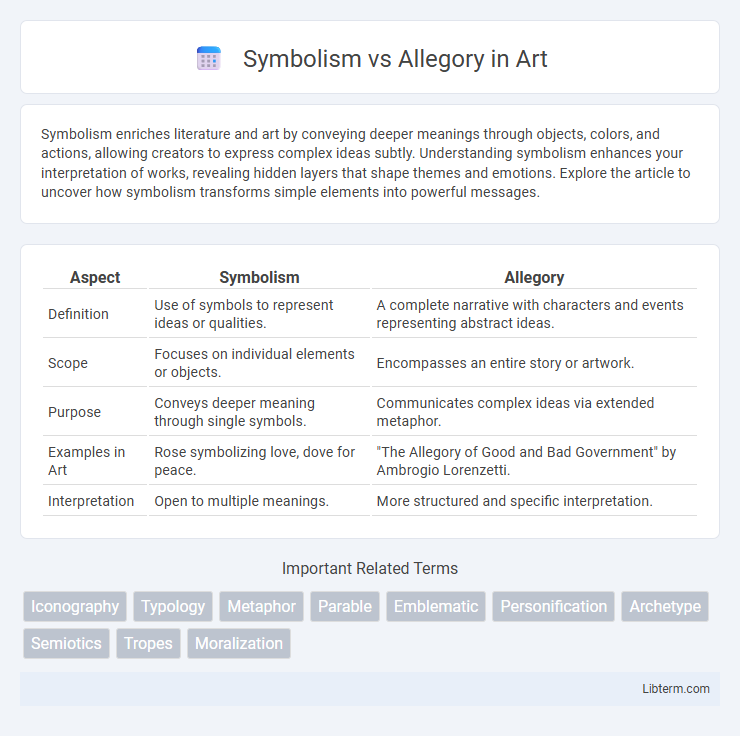Symbolism enriches literature and art by conveying deeper meanings through objects, colors, and actions, allowing creators to express complex ideas subtly. Understanding symbolism enhances your interpretation of works, revealing hidden layers that shape themes and emotions. Explore the article to uncover how symbolism transforms simple elements into powerful messages.
Table of Comparison
| Aspect | Symbolism | Allegory |
|---|---|---|
| Definition | Use of symbols to represent ideas or qualities. | A complete narrative with characters and events representing abstract ideas. |
| Scope | Focuses on individual elements or objects. | Encompasses an entire story or artwork. |
| Purpose | Conveys deeper meaning through single symbols. | Communicates complex ideas via extended metaphor. |
| Examples in Art | Rose symbolizing love, dove for peace. | "The Allegory of Good and Bad Government" by Ambrogio Lorenzetti. |
| Interpretation | Open to multiple meanings. | More structured and specific interpretation. |
Understanding Symbolism: Definition and Key Concepts
Symbolism involves using symbols--objects, characters, or colors--to represent abstract ideas or concepts, enriching a narrative by adding deeper meaning beyond the literal. Key concepts include the symbol's ability to convey multifaceted interpretations and evoke emotional or intellectual responses, often relying on cultural or contextual associations. Understanding symbolism requires recognizing how these indirect representations enhance thematic depth and connect with the audience on a subconscious level.
What is Allegory? An In-Depth Explanation
Allegory is a narrative technique in literature, art, and film where characters, events, and settings represent abstract ideas or moral qualities, creating a layered meaning that conveys a broader message beyond the literal storyline. Unlike symbolism, which uses individual symbols to suggest ideas or qualities, allegory functions as an extended metaphor with a consistent and comprehensive secondary meaning throughout the entire work. Classic examples of allegory include George Orwell's *Animal Farm*, which critiques political systems, and John Bunyan's *The Pilgrim's Progress*, illustrating the spiritual journey of a Christian protagonist.
The Origins: Historical Context of Symbolism and Allegory
Symbolism and allegory both originated from ancient storytelling traditions, with symbolism emerging prominently in early religious and mythological texts where objects and colors represented abstract ideas or spiritual beliefs. Allegory developed as a more structured narrative technique, notably in classical literature and medieval morality plays, where entire stories functioned as extended metaphors conveying ethical, political, or philosophical messages. Historical contexts of symbolism and allegory reflect societies' attempts to communicate complex concepts through layered meanings, influenced by cultural, religious, and intellectual movements of their times.
Core Differences: Symbolism vs Allegory Explained
Symbolism uses individual symbols to represent ideas or qualities, often allowing multiple interpretations within a story or artwork. Allegory is a structured narrative where characters, events, or settings consistently correspond to abstract concepts or moral qualities, conveying a clear, overarching message. The core difference lies in symbolism's flexibility versus allegory's fixed, extended metaphor form.
Symbolism in Literature: Classic and Modern Examples
Symbolism in literature uses objects, characters, or events to represent broader ideas, enriching the narrative with deeper meaning beyond the literal. Classic examples include Nathaniel Hawthorne's "The Scarlet Letter," where the scarlet letter itself symbolizes sin and societal judgment, and modern works like F. Scott Fitzgerald's "The Great Gatsby," where the green light signifies hope and the American Dream. This technique enhances thematic complexity and invites readers to interpret layers of meaning, distinguishing symbolism from the more explicit, often moralistic structure of allegory.
Allegory in Literature: Powerful Examples Through the Ages
Allegory in literature serves as an extended metaphor where characters, events, and settings symbolize broader moral, political, or spiritual meanings, enriching the narrative with layered interpretations. Classic examples include Dante's "Divine Comedy," which explores the soul's journey through Hell, Purgatory, and Paradise, and George Orwell's "Animal Farm," an allegory on Soviet communism critiquing totalitarian regimes through farm animals. Allegories maintain relevance by offering powerful social and ethical commentary, engaging readers in critical reflection beyond the literal text.
Functions and Purposes: Why Authors Use Symbolism and Allegory
Symbolism functions as a literary device that conveys deeper meaning through objects, figures, or colors, allowing authors to evoke emotions and represent abstract concepts subtly. Allegory serves as an extended narrative technique where characters and events systematically embody broader moral, political, or spiritual ideas, providing readers with a structured interpretation of complex themes. Authors use symbolism to enrich the thematic layers and engage readers' imagination, while allegory is employed to communicate explicit messages and critique societal issues through a unified storyline.
Interpreting Symbolism and Allegory: Tips for Readers
Interpreting symbolism requires recognizing objects, characters, or actions that represent broader concepts or ideas beyond their literal meaning, often revealing deeper layers within a narrative. Allegory involves a sustained narrative where characters and events consistently symbolize abstract qualities or moral messages, demanding readers to discern the extended metaphorical framework. Readers benefit from paying close attention to context, recurring motifs, and historical or cultural references to decode these literary devices effectively.
Symbolism and Allegory in Visual Arts and Film
Symbolism in visual arts and film uses objects, colors, or figures to represent ideas or emotions, often conveying deeper meanings beyond the literal. Allegory extends this approach by creating a complete narrative or image where every element stands for a broader concept, often moral, political, or spiritual. In film and art, symbolism provides subtle cues for interpretation, while allegory offers a structured framework for exploring complex themes through visual storytelling.
The Lasting Impact: Symbolism vs Allegory in Contemporary Culture
Symbolism and allegory both shape contemporary culture by embedding deeper meanings within art, literature, and media, yet symbolism relies on singular images or motifs to convey abstract ideas, while allegory uses extended narratives or characters to represent complex concepts. Symbolism influences modern branding and visual storytelling by allowing audiences to derive personal interpretations from iconic symbols, whereas allegory persists in political satire and moral tales, offering layered critiques of society. Their lasting impact is evident in the way they enrich communication, making cultural expressions more profound and resonant across diverse contexts.
Symbolism Infographic

 libterm.com
libterm.com